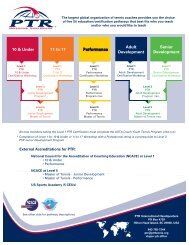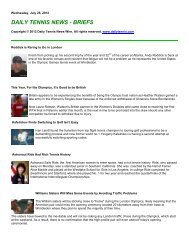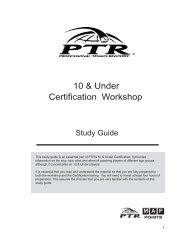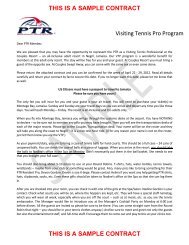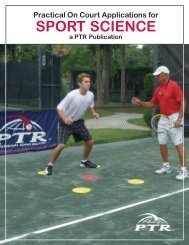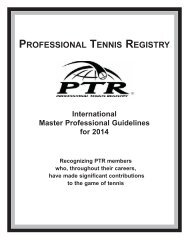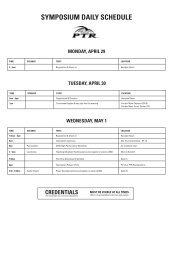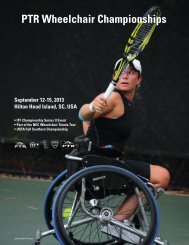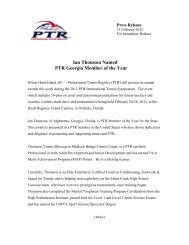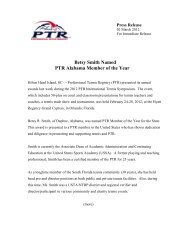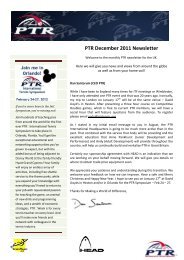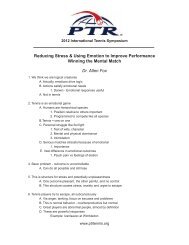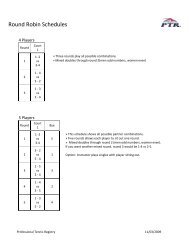Certification Workshop - Professional Tennis Registry
Certification Workshop - Professional Tennis Registry
Certification Workshop - Professional Tennis Registry
Create successful ePaper yourself
Turn your PDF publications into a flip-book with our unique Google optimized e-Paper software.
3. Demo slice<br />
To show slice, rest the racquet behind your shoulder and swing<br />
the racquet up, bypassing the ball at 3 o’clock. The racquet<br />
moves to the ball at a 45-degree angle. There is no follow through.<br />
Note: Remind the students not to “cup” the ball or try to “come around the ball”.<br />
Everyone should still be holding the racquet halfway up the shaft. Most<br />
importantly, it is a short, abbreviated stroke with no follow through.<br />
4. Demo topspin<br />
5. Demo<br />
follow through<br />
From the slice motion, we move to topspin. Rest the racquet<br />
behind your shoulder and move the racquet from 7 o’clock to a<br />
1 o’clock position. The follow through is abbreviated, with the<br />
racquet handle finishing on the outside of the forearm. By correctly<br />
hitting up on the ball, you will create some topspin. Only the<br />
forearm rotates as the wrist rolls with the butt of the racquet.<br />
The next progression is to demonstrate following through behind<br />
your back. At the finish, the back of your hand should be resting on<br />
the small of your back. This will produce greater topspin on the ball.<br />
Caution: Steps 5 & 6 should be done at 1/2 pace - slow motion, because they are<br />
not natural motions. Students who have injured shoulders or elbows may<br />
skip these steps.<br />
6. Add backswing<br />
7. Normal follow through<br />
8. Emphasize<br />
hitting up<br />
The next step is to start with the racquet and ball together and use<br />
a rhythmic backswing and ball toss. (Remember we still have not<br />
moved the grip to the end of the handle.) Again, complete the<br />
stroke by slowly finishing behind the back.<br />
As a next step, demonstrate the topspin serve with a normal follow<br />
through (on the left side of the body).<br />
Finally, have your students hold the racquet full length and move<br />
to the outside of the fence or backdrop. Stand at arm’s length away<br />
from the fence or backdrop and slowly serve over the barrier.<br />
Note: Pronation of the forearm is used in flat, slice and topspin serves. However,<br />
pronation naturally occurs at different times for each type of serve.<br />
Safety Tip: Do not serve in front of a fence pole or any solid object where the ball<br />
might ricochet.<br />
10 PTR ADULT DEVELOPMENT CERTIFICATION WORKSHOP TEST PREPARATION GUIDE



